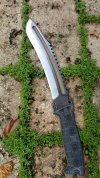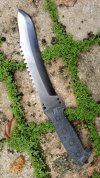You know there's nothing wrong with just doing some batoning on a piece of wood you know is going to split easy to make kindling. It's easy and convenient, but of course there's no machismo in it.
It's when people are trying to make firewood with batoning a knife designed for cutting on a gnarly piece of wood that regardless they would be out of breath trying to split with a 8 lb splitting maul.
Then it becomes a useless endeavor for anything besides entertainment which is fine until we want to complain about why it's not working as if we didn't already understand it was woefully the wrong tool for the job.
I think the biggest problem is too many folks get lost into batoning for the sake of batoning.
It's like its own sport.
Surprised nobody brought up a froe yet
27 doll hairs and it will outperform any knife you can think of for hammering giant pieces of knotted wood if swinging an axe is not your thing.
Can save a ton of money skipping cutting blades and moving over to blade shaped objects.
However, that would be a solution to a problem and when we are batoning gnarly pieces of firewood for sport it's not because we have a firewood problem needing a solution; just doing it for fun.
I think what is fun about a froe is it does this batoning task without any advanced steels.
Geometry, geometry, geometry.
Yet, these threads constantly ignore geometry and just keep pushing "You need to try Brand X or brand Y" or this steel or this heat treatment blah blah blah blah blah.
I'm half tempted to buy a froe and start a thread to complain about why it's not cutting and sharpening very well.
Balance things out a bit from the endless destruction threads.
Maybe my froe is not cutting because it needs to be in CPM 3V?
If only we knew.
Probably make a cool episode on unsolved mysteries.




